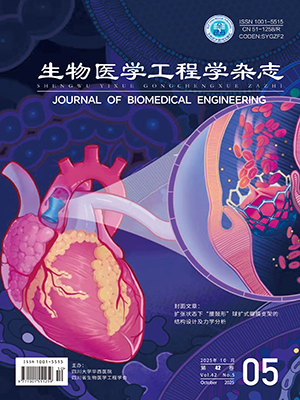| 1. |
Saha S, Baumert M. Intra- and inter-subject variability in EEG-based sensorimotor brain computer interface: a review. Front Comput Neurosci, 2019, 13: 87.
|
| 2. |
霍首君, 郝琰, 石慧宇, 等. 基于深度卷积网络的运动想象脑电信号模式识别. 计算机应用, 2021, 41(4): 1042-1048.
|
| 3. |
Shajil N, Mohan S, Srinivasan P, et al. Multiclass classification of spatially filtered motor imagery EEG signals using convolutional neural network for BCI based applications. J Med Biol Eng, 2020, 40(5): 663-672.
|
| 4. |
Hou Y, Zhou L, Jia S, et al. A novel approach of decoding EEG four-class motor imagery tasks via scout ESI and CNN. J Neural Eng, 2020, 17(1): 016048.
|
| 5. |
Ahn M, Cho H, Ahn S, et al. High theta and low alpha powers may be indicative of BCI-illiteracy in motor imagery. PLoS One, 2013, 8(11): e80886.
|
| 6. |
Lotte F, Bougrain L, Cichocki A, et al. A review of classification algorithms for EEG-based brain-computer interfaces: a 10 year update. J Neural Eng, 2018, 15: 031005.
|
| 7. |
庄福振, 罗平, 何清, 等. 迁移学习研究进展. 软件学报, 2015, 26(1): 26-39.
|
| 8. |
Zhang K, Xu G, Chen L, et al. Instance transfer subject-dependent strategy for motor imagery signal classification using deep convolutional neural networks. Comput Math Methods Med, 2020: 1683013.
|
| 9. |
Ju Ce, Gao Dashan, Mane R, et al. Federated transfer learning for EEG signal classification//2020 42nd Annual International Conference of the IEEE Engineering in Medicine & Biology Society (EMBC). Montreal, Canada, 2020: 3040-3045.
|
| 10. |
Zhu Xuyang, Li Peiyang, Li Cunbo, et al. Separated channel convolutional neural network to realize the training free motor imagery BCI systems. Biomedical Signal Processing and Control, 2019, 49: 396-403.
|
| 11. |
Wang Peitao, Lu Jun, Zhang Bin, et al. A review on transfer learning for brain-computer interface classification//2015 5th International Conference on Information Science and Technology (ICIST). Changsha, China: IEEE, 2015: 315-322.
|
| 12. |
Zhang K, Xu G, Zheng X, et al. Application of transfer learning in EEG decoding based on brain-computer interfaces: a review. Sensors, 2020, 20(21): 6321.
|
| 13. |
Zhao D, Tang F, Si B, et al. Learning joint space-time-frequency features for EEG decoding on small labeled data. Neural Netw, 2019, 114: 67-77.
|
| 14. |
Zanini P, Congedo M, Jutten C, et al. Transfer learning: a riemannian geometry framework with applications to brain-computer interfaces. IEEE Trans Biomed Eng, 2018, 65(5): 1107-1116.
|
| 15. |
He H, Wu D. Transfer learning for brain-computer interfaces: a euclidean space data alignment approach. IEEE Trans Biomed Eng, 2020, 67(2): 399-410.
|
| 16. |
Xu L, Xu M, Ke Y, et al. Cross-dataset variability problem in EEG decoding with deep learning. Front Hum Neurosci, 2020, 14: 103.
|
| 17. |
Kostas D, Rudzicz F. Thinker invariance: enabling deep neural networks for BCI across more people. J Neural Eng, 2020, 17(5): 056008.
|
| 18. |
Parvan M, Ghiasi A R, Rezaii T Y, et al. Transfer learning based motor imagery classification using convolutional neural networks//2019 27th Iranian Conference on Electrical Engineering (ICEE). Yazd, Iran, 2019: 1825-1828.
|
| 19. |
Sakhavi S, Guan Cuntai. Convolutional neural network-based transfer learning and knowledge distillation using multi-subject data in motor imagery BCI//2017 8th International IEEE/EMBS Conference on Neural Engineering (NER), IEEE, 2017: 588-591.
|
| 20. |
Wu H, Niu Y, Li F, et al. A parallel multiscale filter bank convolutional neural networks for motor imagery EEG classification. Front Neurosci, 2019, 13: 1275.
|
| 21. |
Roy S, Chowdhury A, Mccreadie K, et al. Deep learning based inter-subject continuous decoding of motor imagery for practical brain-computer interfaces. Front Neurosci, 2020, 14: 918.
|
| 22. |
Zhang Ruilong, Zong Qun, Dou Liqian, et al. Hybrid deep neural network using transfer learning for EEG motor imagery decoding. Biomedical Signal Processing and Control, 2021, 63: 102144.
|
| 23. |
Özdenizci O, WANG Y e, Koike-Akino T, et al. Transfer learning in brain-computer interfaces with adversarial variational autoencoders//2019 9th International IEEE/EMBS Conference on Neural Engineering (NER). San Francisco, USA, 2019: 207-210.
|
| 24. |
Kant P, Laskar S H, Hazarika J, et al. CWT based transfer learning for motor imagery classification for brain computer interfaces. J Neurosci Methods, 2020, 345(2020): 108886.
|
| 25. |
Xu Gaowei, Shen Xiaoang, Chen Sirui, et al. A deep transfer convolutional neural network framework for EEG signal classification. IEEE Access, 2019, 7(1): 112767-112776.
|
| 26. |
Vidaurre C, Blankertz B. Towards a cure for BCI illiteracy. Brain Topogr, 2010, 23(2): 194-198.
|
| 27. |
Simonyan K, Zisserman A. Very deep convolutional networks for large-scale image recognition. 2014, arXiv:1409.1556v6.
|
| 28. |
Yosinski J, Clune J, Bengio Y, et al. How transferable are features in deep neural networks?// Proceedings of the 27th International Conference on Neural Information Processing Systems. Cambridge: IEEE, 2014, arXiv: 1411.1792v1.
|




